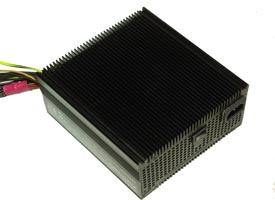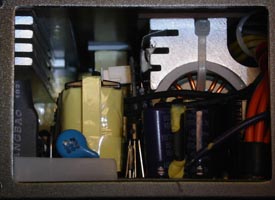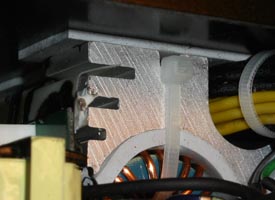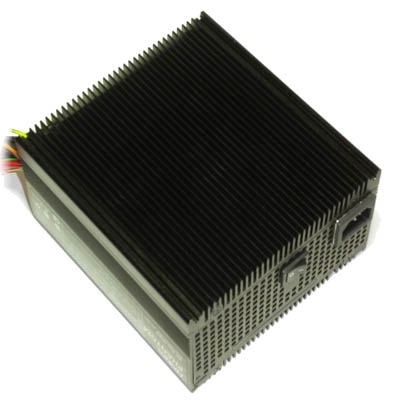Silence is a conception which is a not all too known phenomena in computer contexts. There is a computer buzzing in almost every home now, and the buzz comes mainly from the fans.
Silence is a conception which is a not all too known phenomena in computer contexts. There is a computer buzzing in almost every home now, and the buzz comes mainly from the fans. The manufacturers of fans has had a ”happy hour” since the computer became a product which everyone could afford. A couple of years ago really silent processor fans begun to appear in stores, and a fan was released that was only for the Nordic market, the Thermaltake Viking, just like if we here up north are sensitive to noise. The whole thing was a Thermaltake Volcano 7 with a more silent fan, and voilá, it became a Viking, only for the noise sensitive north people. Anyway, after that it came fanless processor coolers and power supplies with variable fan speed, but there it stopped. It came other cooling methods for processors such as water cooling, but there was no better solution for power supplies than fans, silent ones.
Today that will change, or at least a try to. If you’re always dreamed of a silent computer you have a golden opportunity to get a bit closer to that dream today. Into the market Antec comes with a power supply with no fans, the Phantom 350W. This power supply has been on the market a while now and we’ve studied it and tested it into the last detail, so you’re welcome to see how it went.
| Specifications | |
|---|---|
|
Voltage/Current
|
|
|
+3.3VDC
|
28A
|
|
+5VDC
|
30A
|
|
+12VDC
|
18A
|
|
+12VDC (ATX12V)
|
16A
|
|
-5VDC
|
–
|
|
-12VDC
|
0.5A
|
|
+5VSB
|
2A
|
|
Maximum load
|
334W
|
|
Maximum load +3.3V & +5V
|
190W
|
|
Connections
|
|
|
Molex connections
|
7
|
|
Floppy connections
|
2
|
|
Serial-ATA
|
2
|
|
Other connections
|
ATX12V, PCI-E
|
|
Other Specifications
|
|
|
Fans
|
–
|
|
Certifications
|
UL, CUL, CB, FCC class B och TÜV
|
|
Other
|
Gold plated connectors, 20->24 pin adapter, power cable
|
|
Warranty
|
3 years, AQ3
|
|
Price
|
1500 SEK ( Exchange rates )
|
The box that contains the Antec Phantom 350W is not special, but on the other hand, it’s not the box that we’re using in the computer. What’s more interesting is how the PSU looks and how it performs in our tests.
The Phantom 350W comes with Antec’s “Antec Quality”, AQ3-warranty. In short terms, that means that you get a 3-year warranty on the production and components. More and more manufacturers discover that the consumers want longer warranty. Just take e.g. hard drives. When one of the biggest manufacturers lowered the warranty on their desktop-hard drives from three years to one year, there was lots of commotion. Anyway, Antec’s Phantom 350W weighs in at 2.7 Kg and that is a lot more than the average for a PSU. Most of the weight constitutes of aluminum, black good-looking aluminum. The PSU is manufactured according to the ATX 2.2-standard, and you can read about threshold values and so on in our earlier review here.
 |
 |
As I mentioned earlier, this PSU is very heavy and very solid, all to be able to divert the heat from the components in the PSU. Passive cooling puts heavy demands on construction and components, but Antec seems by first appearances to have succeeded. The heat developing components are attached to the aluminum with heat conducting material.
 |
 |
On the pictures above, one of the sheet metals have been removed so that you are able to see what’s hidden under the black metal. Observe that if you do this, you void your warranty and I did this so that you readers don’t have to do it. On the right picture above you can see the coil; the blue round thing with copper wirers that is tightened with a cable tie against an aluminum heat spreader. Heat conducting material has been placed between the coil and the heat spreader. This helps to remove heat and makes the coil quiet, because often coils make a whining noise. Now that we have introduced you to the PSU and its inside, we move ahead to our test bench to see how it performs.
Our synthetic tests are executed in two parts, one low power test and one high power. The power supply runs for about a half hour, with an opening period of low power and then a high power test. During the low power test the three main voltages (+3.3V, +5V and +12V) are put under a load of about 1 Ampere each. This test is to see how the power supply works when ”idle”.
During the high power test, the three voltage lines are put under maximum load to see if the power supply can keep the voltages and ripple within the thresholds. This is to see if the PSU can live up to its promises. Ripple and voltages are continuously measured throughout the two tests. The second stage is done in a regular computer. Well then, let us head into the land of heat development.
Phantom 350W manages to keep the voltages very stable, and the ripple is so low that it is not even worth showing in a chart. The voltages are, while being stable, a little bit on the low side. At such a low power usage, 30 Watts in this case, the power supply could have used a slightly higher overvoltage to be able to compensate later at higher power usages. Of course, we have yet to observe this.
After about 30 minutes of maximum load, the power supply is just a little warm, 46°C. It is simply amazing that it does not get any hotter. I have put the PSU under maximum load, and this is as hot as it gets. The voltages have decreased, of course, and are all a bit below specified values. There is some room left before they pass the thresholds, but it is no big deal. The ripple is nothing to worry about either, the one closest to the threshold value is 3.3 V with its ripple of 60 mV, where the maximum ripple allowed is 70 mV. Best of all, though, is the sound, or noise, from the power supply. There is none! A power supply which is this quiet and performs so well is is truly proof of good engineering. Antec has succeeded in creating a PSU with passive cooling which performs as well as other power supplies, really well done!
|
Test system Computer
|
|
| Processor: |
AMD Athlon 64 3000+ Socket 939
|
| Chassi: |
Standard Midi-ATX
|
| Mainboard: |
MSI K8T Neo2 |
| Memory: |
1024MB Crucial DDR-SDRAM |
| Graphic card : |
MSI 6800 NX-TD 128Mb |
|
Harddrive:
|
IBM GXP-120 80 GB, 60 GB, Hitachi Deskstar 40GB
|
|
Software
|
|
| Operating system : |
Windows XP Professional SP1
|
|
Benchmarking software:
|
Sisoftware Sandra 2004 |
The test system is based on a mainboard with Athlon’s socket 939, over clocked to 2.3 GHz. Three hard drives and a mid-range video card make out the base in the test system. The over clocked processor has ”Cool ’n Quiet” switched off to keep it from giving odd test results. The use of three hard drives is to compensate somewhat for the power efficient CPU. We want the power supply to show it’s worth in the real world, under genuine circumstances.
After our test run it shows that the PSU manages to keep the voltages right on their respective values. The voltages did not fluctuate much at all, even though the values were measured both during full load and when the CPU and video card were idle. Heat development in the power supply is nothing to worry about, either. It gets warm, but doesn’t heat up noticeably. Worth mentioning in the table is that the 4-pin connector which supplies the CPU with power (12V1) carries a heavier load than 12V2. This is good since it is how the ATX specification is meant to work, 12V1 supplies the CPU with power and 12V2 supplies the other components and, when needed, also the CPU.
Antec has for a long time been at the peak of the development. It now seems as if they’ve succeeded once again with a piece of art when it comes to construction, this time with a completely silent power supply unit. A quiet PSU is what many people have been waiting for and now it’s available on the market. I tip my hat and bow to this achievement and thank my lucky star for the now available alternative to ”quiet” PSU’s that are everything but quiet when it really matters.
I have to warn those who are thinking about getting components for their quiet computer. When it comes to the Phantom 350W, there has to be something that creates a flow of air in the computer. If you use a passive CPU cooler and then get a Phantom 350W, there has to be at least one fan, otherwise the air inside the computer could reach temperatures high enough to damage the processor, the PSU or some other component. This is where the problems appear, a catch 22. A passive CPU cooler must have a PSU with a fan, or some other rear fan to be able to operate normally. A PSU with passive cooling relies on that there is something else in the computer that transfers the air out of it.
To not put you off completely, I can tell you that there are many manufacturers today that make quiet fans and you can build a very quiet computer by using fans like those, and an Antec Phantom 350W. Phantom 350W is a very nice PSU that offers excellent performance, though it has a somewhat high price. If you only need a PSU because your old one is on the verge of breaking, the price is high, but if you want a really quiet component for your computer, old or not, the price is acceptable. When doing normal computer tasking, the PSU won’t get hotter than lukewarm which is very nice when keeping in mind that other PSU’s can get really hot even though they’re equipped with a fan.
The Antec Phantom 350W is a component that you can invest in without any concerns if you seek components for the quiet computer. A good-looking, heavy and well-performing PSU is what we’ve seen here today.
Antec Phantom 350W

Pros:
+ Antec’s AQ3 guarantee
+ ATX 2.2 specification
+ Stable voltages
+ Completely silent
Cons:
– Price
With its Phantom 350W, Antec has created a very attractive product for those who are looking to create a really quiet system. A fully passively cooled PSU that is more or less silent and is shown by our tests to have no problems with the cooling. This is achieved through a very effective and innovative construction of the chassi that also acts as a heatsink. Even though Antec isn’t the first manufacturer of passive PSU’s, we think that they’ve succeeded better than many others, which is why we give the Antec Phantom 350W our innovation award.






















Leave a Reply